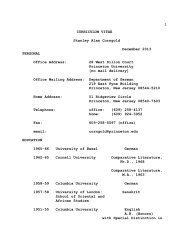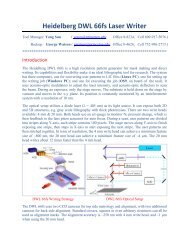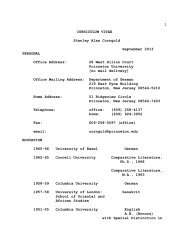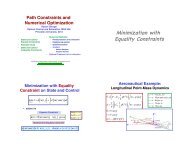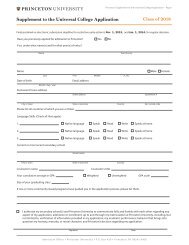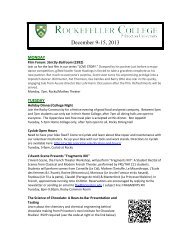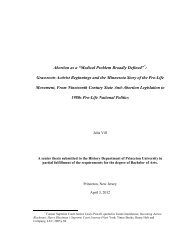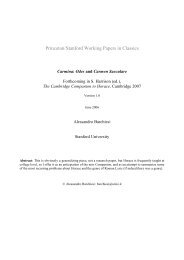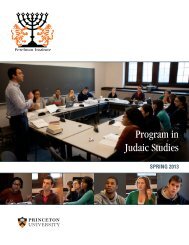George Larkin and the London literary underground 1666-1690 ...
George Larkin and the London literary underground 1666-1690 ...
George Larkin and the London literary underground 1666-1690 ...
You also want an ePaper? Increase the reach of your titles
YUMPU automatically turns print PDFs into web optimized ePapers that Google loves.
© Martin Dzelzainis 6<br />
So by <strong>the</strong> mid-1670s an unlikely anti-Company coalition had formed, comprising<br />
L’Estrange, Seymour, <strong>and</strong> those who were ‘obnoxious to <strong>the</strong> Company’ like <strong>Larkin</strong> <strong>and</strong><br />
Smith. Actuated by <strong>the</strong> principle that my enemy’s enemy is my friend, agents of <strong>the</strong> state <strong>and</strong><br />
those opposed to it (or who at least wished to capture its machinery for <strong>the</strong>ir own political<br />
ends) could co-operate with each o<strong>the</strong>r. But in doing so were <strong>the</strong>se opposition figures<br />
fur<strong>the</strong>ring or compromising <strong>the</strong>ir radical aims?<br />
The coalition did not survive <strong>the</strong> lapse of <strong>the</strong> Licensing Act in June 1679 or <strong>the</strong> Exclusion<br />
***<br />
Crisis, when Smith worked with Titus Oates <strong>and</strong> Shaftesbury <strong>and</strong> <strong>Larkin</strong> set up his own press<br />
again. Smith, however, was abroad or in prison between 1681 <strong>and</strong> 1688 <strong>and</strong> <strong>Larkin</strong> <strong>the</strong>refore<br />
assumed greater importance as a Baptist publisher, printing works by William Kiffin,<br />
Benjaminin Keach <strong>and</strong> William Pardoe among o<strong>the</strong>rs. But it was as <strong>the</strong> Tory Reaction<br />
ga<strong>the</strong>red pace in <strong>the</strong> 1680s that <strong>Larkin</strong> both produced works which challenged <strong>the</strong> legality of<br />
ecclesiastical courts <strong>and</strong> acted as a publisher of prison-writings from Newgate <strong>and</strong> elsewhere.<br />
Some of his commercial imprints also carried a political charge William Dockwra’s<br />
1681 prospectus for <strong>the</strong> penny post was backed by <strong>the</strong> Whigs. Dockwra’s partner, Robert<br />
Murray, was one of Shaftesbury’s agents while ano<strong>the</strong>r “undertaker” was <strong>the</strong> republican<br />
Henry Neville. Heraclitus Ridens warned of <strong>the</strong> threat posed by <strong>the</strong> penny post: ‘There was<br />
never anything so favourable to <strong>the</strong> carrying on <strong>and</strong> managing Intrigue … That <strong>and</strong> <strong>the</strong> Press<br />
being unpadlockt, are two incomparable twins of <strong>the</strong> Liberty of <strong>the</strong> Subject! One may Write,<br />
Print, publish <strong>and</strong> disperse ingenious Libels … <strong>and</strong> no body <strong>the</strong> … wiser for it’. 17 In 1682,<br />
<strong>Larkin</strong> printed two editions of An account of <strong>the</strong> province of Carolina for Francis Smith. The<br />
prospectus was written by Samuel Smith, Locke’s successor as Shaftesbury’s secretary.<br />
Although colonists were being sent out, witnesses to <strong>the</strong> Rye House Plot revealed that <strong>the</strong><br />
Carolina project had became a cover for negotiations between <strong>the</strong> English <strong>and</strong> Scottish<br />
conspirators. Finally, Ichabod Chauncey, whose Innocence vindicated <strong>Larkin</strong> printed in 1684,<br />
was a member of <strong>the</strong> Castle Street congregation <strong>and</strong> two electioneering clubs in Bristol,<br />
which were also connected with <strong>the</strong> Rye House Plot. 18<br />
17 See Susan E. Whyman, ‘Postal Censorship in Engl<strong>and</strong> 1634-1844’, pp. 10-12, available at<br />
www.postcomm.gov.uk/about-<strong>the</strong>-mail-market/uk-market-reviews/postalcensorship.pdf<br />
18 See K. H. D. Haley, The first earl of Shaftesbury (Oxford 1968), pp. 231-55, 242-8, 365-6, 705-7; for<br />
The fundamental constitutions of Carolina (1669), see John Locke, Political essays, ed. Mark Goldie<br />
(Cambridge, 1997), pp. 160-81. For <strong>the</strong> Rye Houser Plot, see Thomas Sprat, A true account <strong>and</strong><br />
declaration of <strong>the</strong> horrid conspiracy against <strong>the</strong> late King (<strong>London</strong>, 1685), pp. 25-6, 65, 91, 101, 106,<br />
116, 130, <strong>and</strong> Copies of <strong>the</strong> information <strong>and</strong> original papers relating to <strong>the</strong> proof of <strong>the</strong> horrid<br />
conspiracy against <strong>the</strong> late king (<strong>London</strong>, 1685), pp. 16, 35, 48, 55, 95, 104, 127-8; <strong>and</strong> Richard L.<br />
Greaves, Secrets of <strong>the</strong> kingdom. British radicals from <strong>the</strong> popish plot to <strong>the</strong> revolution of 1688-1689<br />
(Stanford, 1992), pp. 35, 97, 137, 163-4. For Bristol, see Jonathan Barry, ‘The Politics of Religion in<br />
Restoration Bristol’, in The politics of religion in restoration Engl<strong>and</strong>, ed. Tim Harris, Paul Seaward,<br />
<strong>and</strong> Mark Goldie (Oxford, 1990), p. 176; Douglas R. Lacey, Dissent <strong>and</strong> parliamentary politics in<br />
Engl<strong>and</strong>, 1661-1689 (New Brunswick, NJ, 1969), p. 162; Ichabod Chauncey, Innocence vindicated, pp.




